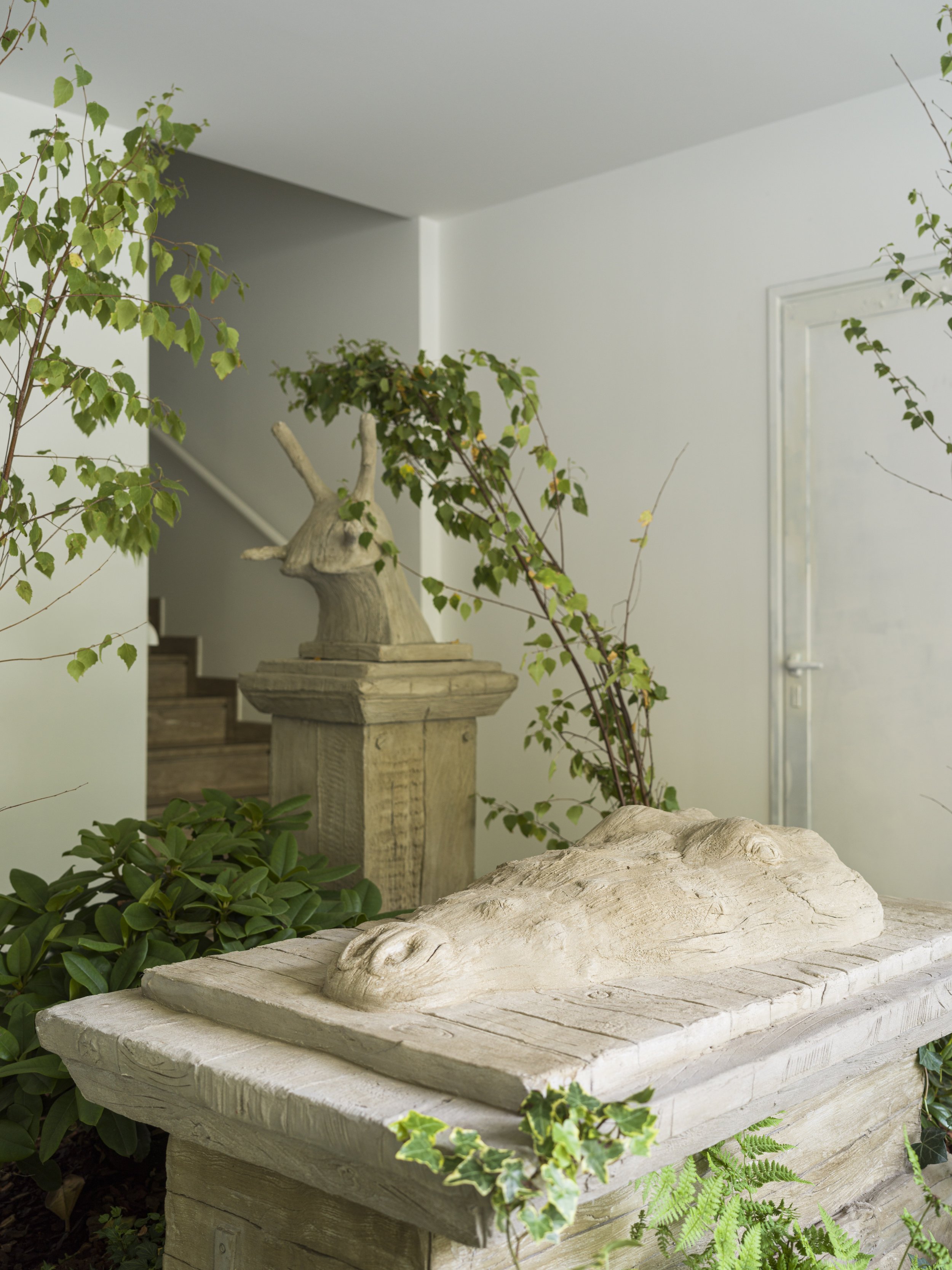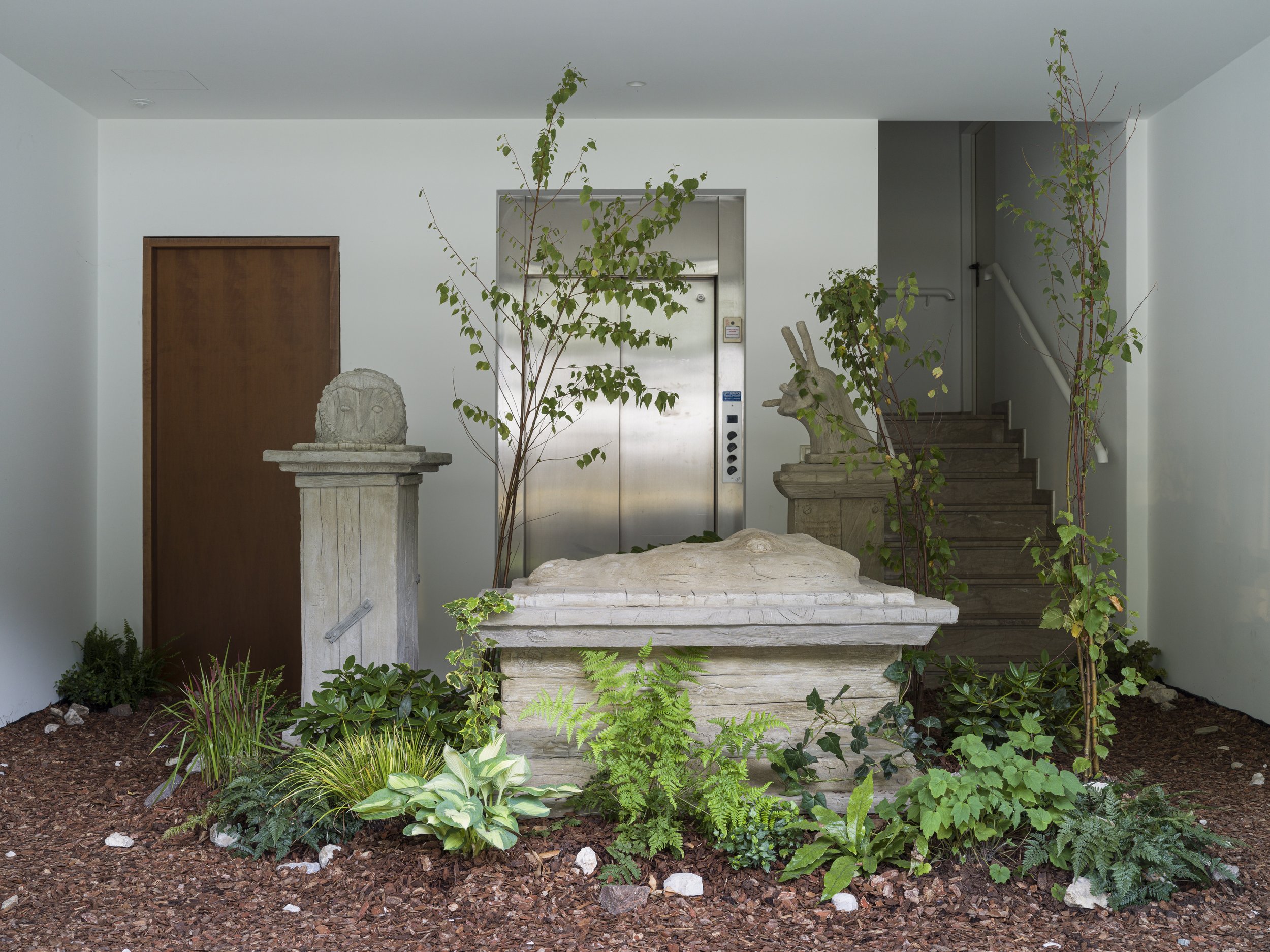
Laurent Le Deunff, Chouette des neiges, Crocodile, Escargot, 2024. Installation with Concrete Sculptures, Earth, Tree Bark, Dead Leaves, Moss and Various Species of green Plants and Saplings. Variable Dimensions. Courtesy of the Artist and Semiose, Paris. Photo by Tiberio Sorvillo

Laurent Le Deunff, Chouette des neiges, Crocodile, Escargot, 2024. Installation with Concrete Sculptures, Earth, Tree Bark, Dead Leaves, Moss and Various Species of green Plants and Saplings. Variable Dimensions. Courtesy of the Artist and Semiose, Paris. Photo by Tiberio Sorvillo

Laurent Le Deunff, Chouette des neiges, Crocodile, Escargot, 2024. Installation with Concrete Sculptures, Earth, Tree Bark, Dead Leaves, Moss and Various Species of green Plants and Saplings. Variable Dimensions. Courtesy of the Artist and Semiose, Paris. Photo by Tiberio Sorvillo
Laurent Le Deunff
1977, France
EN Laurent Le Deunff has a marked preference for traditional art and crafts, which he often uses with the intention of generating perceptual trickery, playing on the discrepancy between materials and depicted objects. His sculptural and graphic works often become part of site-specific installations. Le Deunff often realises site-specific installations in which he combines sculptural and graphic works, as inMy Prehistoric Past(2022), where he explored common forms of natural history display in museums, such as dioramas, trompe-l’oeils and cabinets of curiosities, by embedding his sculptures, drawings and bas-reliefs in immersive landscapes. In a play of surprising forms, materials and scales, Le Deunff creates images and stories, questioning concepts such as replica and “fake” between artisanal and industrial production and between profane and sacred meanings.At the entrance to the offices of the Biennale Gherdëina in the artisanal area of Pontives, Le Deunff recreated the scenery of a fairytale forest using earth andt ree bark, dead leaves, moss and various species of green plants and saplings as a continuation of his 2021 installationThe Mystery of Sculpting Cats.Visitors walkalong a kind of small path, encountering three sculpted heads of animals thatthe artist places on plinths akin to tombstone effigies: a snow owl, a crocodile and a snail. The sculptures were made using the rocailles technique, popular in nineteenth-century France, in which concrete is carved to make the objects lookas if they were made of wood. In this surreal scenario, the use of this technique transports us into a world somewhere between the pet cemetery, the grotesque andthe kitsch decorations that characterise certain small gardens. The construction of this micro-park inside a modern building in the artisanal area of Val Gardena, in an area known exclusively for its beautiful natural landscape and its centuries-old tradition of woodcarving, reminds us that things are not always what they seem.
IT Laurent Le Deunff ama le tecniche artistiche e artigianali tradizionali, che utilizza con l’intento di generare inganni percettivi, giocando sulla discrepanza tra materiali e oggetti raffigurati. Spesso realizza delle installazioni site-specific in cui inserisce le sue opere scultoree e grafiche. In My Prehistoric Past (2022), l’artista esplora le forme di rappresentazione scientifica comunemente presenti nei musei tra diorami, trompe-l’oeil e gabinetti di curiosità attraverso sculture, disegni e bassorilievi posizionati in paesaggi immersivi. In un gioco sorprendente di forme, materiali e dimensioni, Le Deunff crea immagini e storie che esplorano i concetti di replica e di falso, tra produzione artigianale e industriale, tra significati profani e sacri. All’ingresso degli uffici della Biennale Gherdëina, nell’area artigianale di Pontives, Le Deunff ha ricreato lo scenario di una foresta fiabesca utilizzando terra, corteccia d’albero, foglie secche, muschio e varie specie di piante verdi e alberellicome continuazione della sua installazione del 2021The Mystery of SculptingCats. Percorrendo una sorta di piccolo sentiero, le persone incontrano tre sculture simili a effigi tombali: posizionate sui plinti troviamo le teste di un gufo delle nevi, un coccodrillo e una lumaca. Le sculture sono state realizzate con la tecnica della decorazione a rocaille, diffusa nella Francia del XIX secolo, in cui il cemento viene intagliato per far sembrare di legno gli oggetti.In questo scenario surreale, l’uso di questa tecnica ci trasporta in un mondoa metà tra il cimitero degli animali, il grottesco e la decorazione kitsch che caratterizza i giardinetti. La costruzione di questo micro-parco all’interno di un edificio moderno nella zona artigianale della Val Gardena, in un’area nota esclusivamente per il suo meraviglioso paesaggio naturale e per la sua secolare tradizione di sculture in legno, ci ricorda che le cose non sono sempre come sembrano.
DE Laurent Le Deunff hat eine ausgeprägte Vorliebe für traditionelleTechniken aus der Welt des Kunsthandwerks, wobei er das Auge derBetrachter*innen oft durch die Diskrepanz zwischen den verwendeten Materialien und den dargestellten Objekten täuscht. Er realisiert häufig raumbezogene Installationen, in denen er bildhauerischen und zeichnerischenWerke kombiniert, so wie inMy Prehistoric Past(2022), wo er in Museen üblich naturwissenschaftliche Darstellungsformen wie Dioramen, Trompe-l’oeils undKuriositätenkabinetten untersuchte, indem er seine Skulpturen, Zeichnungen und Flachreliefs in immersive Landschaften einbettete. In einem Spiel vonüberraschenden Formen, Materialien und Maßstäben erzeugt Le Deunff Bilder und Geschichten, und stellt dabei Begriffe wie Nachbildung und “Fake” zwischenhandwerklicher und industrieller Produktion sowie zwischen profanen und sakralen Bedeutungen in Frage. Im Eingangsbereich des Büros von BiennaleGherdëina in Pontives realisierte Laurent Le Deunff als Fortführung seiner2021 realisierten InstallationThe Mystery of Sculpting Catseine märchenhafteWaldszene mit Erde und Baumrinden, abgestorbenen Blättern, Moos und verschiedenen Grünpflanzen und jungen Bäumen. Die Besucher*innen, die indie oberen Ausstellungsräume gehen, bewegen sich auf kleinen Wegen zwischen dem erdigen Boden und einer Reihe von drei Tierköpfen, die der Künstler auf grabmalähnlichen Sockeln positioniert hat, so eine Schnee-Eule, ein Krokodilund eine Schnecke. Diese wurden in der im Frankreich des 19. Jahrhunderts gebräuchlichen Dekorationstechnik des Rocailles hergestellt, in welcherBeton so geschnitzt wird, dass die Objekte aussehen, als wären sie aus Holz.In diesem unwirklichen Szenario versetzt uns die Verwendung dieses Faux-Bois-Stils in eine Welt zwischen Haustierfriedhof, Groteske und kitschigerGartendekoration. Die Konstruktion dieses kleinen Parks im Inneren eines modernen Gebäudes in der Industriezone von Gröden, in diesem Tal, das neben der wun der baren Naturlandschaft auch durch seine jahrhundertelange Tradition der Holzschnitzerei bekannt ist, erinnert uns daran, dass die Dinge nicht immer so sind, wie sie scheinen.
LA Laurent Le Deunff à na gran preferënza per la tecniches d’ert y d’artejanattradiziuneles che l tol ca suvënz per ngiané la perzezion de chëi che cëla progaujan na contradizion danter materiai adurvei y i ogec mustrei. L fej suvënz nstalazions aldò dl post ulache l mët ora y ulache l sënta ite si scultures y dessënies,sciche teMy Prehistoric Past(2022), ulache là nrescì diorams, “trompe-l’oeils“y cabinëc dla curiositeies tipichs di museums metan scultures, dessënies y bas-reliefs te cuntredes immersives. Te n juech de formes, materiai y proporzionsmët Laurent Le Deunff al mont imajes y stories y mët n cuestion la nuzion dereplica y “fake“ danter la produzion artejanela y industriela y l valor dl profan yl sacral. A unì ite ti ufizies de Biennale Gherdëina tl raion artejanel de Pontivesà Le Deunff fat do na szena de n bosch de marueia tulan ca tiera, scorzes di lëns,pleces sëces, mustl y d’uni sort de plantes vërdes y piciuei. I vijitadëures che vasu aut tla sales de mostra, se muev sun pitli troies, danter l fonz de tiera y nsecuënza de trëi cëves de tieres che l artist à metù ju sun na fundamënta sciche nafòssa, y plu avisa na ciafita dla nëif, n cocodril y n snech. Chisc ie unii fac tl stildecuratif rocailles, coche l fova usanza fé tla Franzia dl 19ejim secul y ulache nziplova tl peton a na maniera che l cëla ora sciche sce l fossa lën. Te chësc cialéora nia reél nes porta l’adurvanza de chësc stil te n mond danter curtina di tieres,ert grotesca y decurazion kitsch di verzons. L fé su chësc pitl parch tl dedite de nfrabicat modern te n raion artejanel de Gherdëina, te chëla valeda cunesciuda persi natura de marueia y nce per la tradizion dl ziplé de seculi, nes lecorda che lacosses ne ie nia for coche les semea.